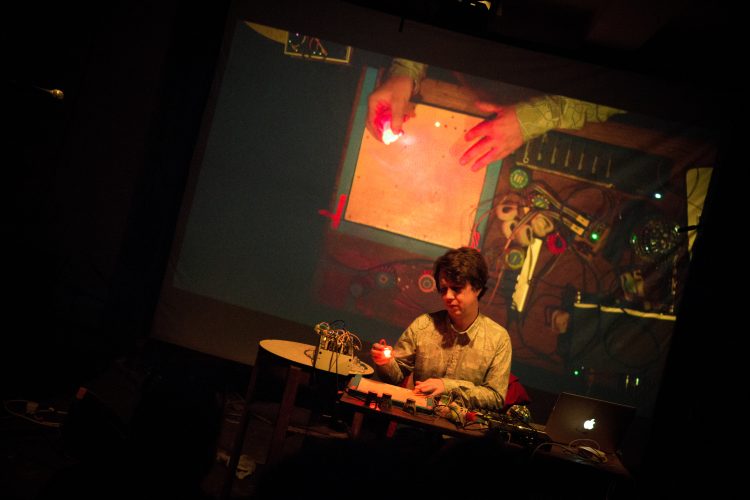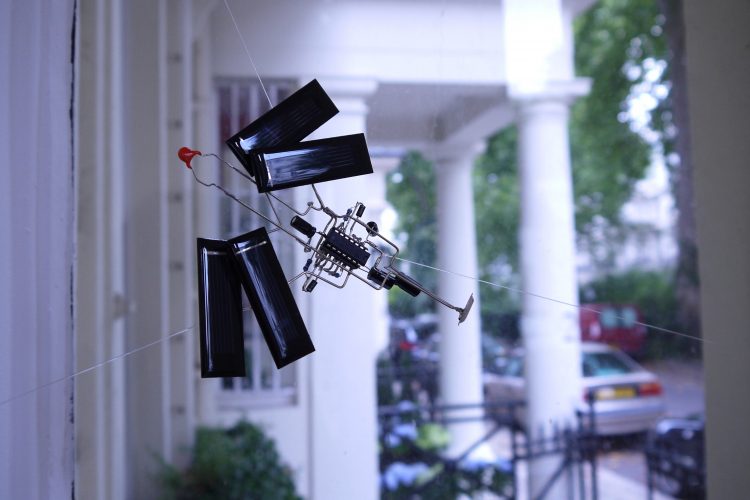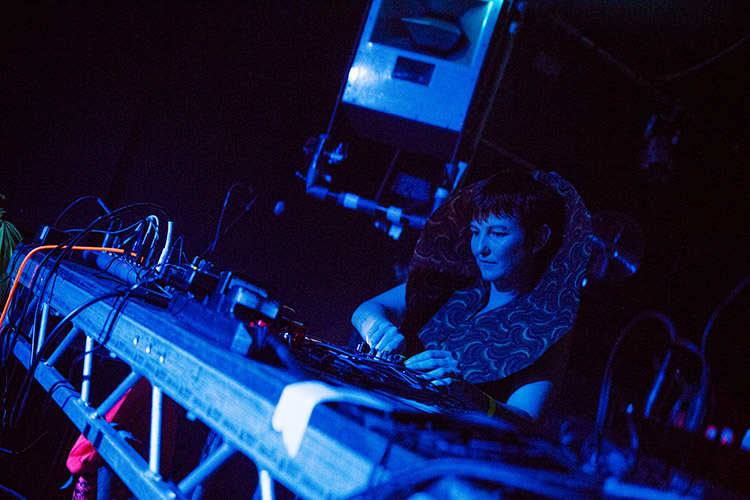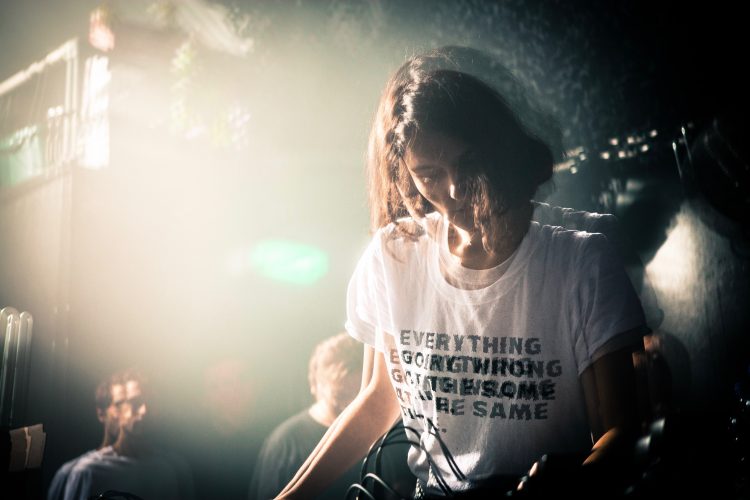Electro insects, ready-to-wear synths and algo rave in London
Published 9 October 2017 by Elsa Ferreira
A titanic program for an extraordinary festival. On September 20-30, London celebrated Unconscious Archives, a festival at the crossroads of arts, music and DIY.
London, from our correspondent
What a week! It started off on a bad foot, as we were refused entry to Cafe OTO, which was hosting the first evening event of the Unconscious Archives festival on September 24. Sold out. Oh well, we thought we might be among the rare oddballs to attend this strange DIY experimental performance with light and sound.

A bit presumptuous perhaps, given the festival’s rich programming by Sally Golding, an Australian artist and curator based in London. Four years after its first edition, and just as many series of Unconscious Archives events, this year’s complete festival presented some 40 artists over three evenings and an exhibition. 500 visitors later, plus hundreds more in the exhibition, the 2017 edition is a success. “People have a real curiosity for diversity,” says Golding. “By mixing the scenes (film, noise, clubs), we bring together people of sometimes different interests.”
Campfire and electronic landscapes
The first night, Compositional Constructs brought together inventor artists who make their own complex, poetic and luminous machines, both literally and figuratively.
Dutch artist Mariska de Groot opened the evening with Stirred Mandala, a circular performance as a sort of 360-degree theremin. “It’s incredibly innovating,” remarked Tom Matchett, founder of FAD Live, the video component of FAD contemporary art magazine, which documented the entire festival. “The way she interacts with her instrument, changing the textures… It’s a very powerful feeling of immediacy.”
Leafcutter John, a.k.a. John Burton, who headlined the night (his name has outgrown the experimental scene thanks to his post-jazz group Polar Bear), presented Light Interface, a photo-sensitive grid on which he reflected various luminous objects, such as a hanging bicycle light and mini disco ball. “An ethereal musical journey through a responsive interpretative synthesized electronic landscape,” wrote Tom Matchett.
“Stirred Mandala”, Mariska de Groot, Unconscious Archives 2017, by FAD Live:
Austrian artist Dawid Liftinger enchanted his audience with his digital interface of software, Arduino and circuit relays switching fluorescent tubes on and off in the dark, triggering crackling sounds that were recorded and amplified, like an electronic campfire. Myriam Bleau, a digital artist from Montreal, concluded the dance with Soft Revolvers, an installation made up of luminous and translucent spinning tops that control an LED while generating music to the tempo of rotations per minute, as motion data was collected by sensors placed inside the tops, each associated with a different musical “voice”.
Algorave and stroboscopic hallucinations
We didn’t mind missing all that once we visited the Emotion + the Tech(no)body exhibition at Austrian Cultural Forum London. This somewhat eerie show interpreted our cultural and emotional attachment to data and the corporal link to technology. In Davide Bevilacqua and Veronika Krenn’s In Summer Nights I looked for Insects (2017), cicadas and other insects from our summer nights became creatures on screens and electronic circuits whose song modulated as each visitor passed by. In the basement, Audrey Samson held a funeral rite for our data in her installation Goodnight Sweetheart (2015), embalming her USB sticks and GPS devices in plastic. At the entrance, the palm lines of artist Reni Hofmüller are displayed extra-large and in conductive electric tape.

The full extent of this year’s musical program finally revealed itself on September 28 at Haptic Somatic. Both rooms at Corsica Studios, one of London’s most refined electronic music clubs, saw a succession of noise and experimental artists performing for a converted crowd. Composer Laurie Tompkins gave an erratic performance based on IKEA bags and displaced sounds, while Australian foley artist Tara Pattenden, alias Phantom Chips, showed off her homemade ready-to-wear synths. But we were especially waiting for Yaxu, cofounder of the Algorave movement, live coding parties where music and visuals are composed on the spot. For half an hour, the Sheffield artist improvised before our eyes with samples and codes. “Algorithmic generation, we love repetition,” his computer sang.

Honorable mention went to Ewa Justka, a Polish artist based in London who couldn’t care less about pandering. Installing her mixing table in the middle of the room, her white t-shirt bearing the words “Everything going wrong at the same time”, she shot off several thousand-watt strobe lights accompanied by sound so violent that some viewers experienced visual distorsions… before cutting off the sound as brutally as it began. Mic drop. Roaring applause from an amused and disoriented audience.
The evening concluded somewhat more gently with German producer Ziúr, who presented her first album, U Feel Anything, released October 6 on the Intelligent Dance Music label, Planet Mu. A demanding and ambitious textured sound experience against a backdrop of animated LEDs.

Silent movies that spoke to us
The generous and expert program was fully assumed by Sally Golding, herself a performing artist and curator since 2004. That’s her secret—she knows how hard it is to present live experimental art: “It’s important to understand how the artist’s work is created, and how it can be staged, presented and put forward.” Sally created the festival in her image, by digging into her own work, in which she mixes lighting, sound art and film projection.
“Spirit Intercourse”, Sally Golding (2015):
After the DIY lights of Compositional Constructs and the sonic Haptic Somatic, film took center stage for Narrativize on the last night of the festival. The venue was once again carefully chosen: Close-Up, an art house theater in the back of a bar that rents indie film DVDs and a provides a library of film books in the heart of the artsy Shoreditch neighborhood, hosted some 40 people for a live film screening.
The conceptual introduction took the form of poetry performed in two voices by two members of the group Secluded Bronte over images of a moldy 16mm reel depicting a cinematic essay on failure, all staged into a sophisticated display. The rest was more accessible: London artist Foxy Moron lulled visitors with her theremin and her layered voice, telling the story of Bussa, a slave from Barbados who led one of the largest rebellions of the British colonial territories. On the screen she displayed her web searches, tabs included—“a very intimate act in 2017,” she explained. She was followed by Esperanza Collado, a Spanish artist and researcher who presented a silent film that intimated to the public all sorts of actions, such as looking in the direction of the projectionists or shouting at the top of their lungs in this soundproof room (“A unique opportunity,” the film insisted. We didn’t wait to be told twice…).
The festival closed just as ingeniously as it opened—but this time, we were there! With his piece abcdefghijklmnopqrstuvwxyz, Austrian artist Jörg Piringer played his homemade software, whispering live sound effects to make letters dance, swirl, bounce and explode on the big screen. Poetic simplicity as a testament to technological virtuosity… What a week!
“abcdefghijklmnopqrstuvwxyz”, Jörg Piringer, Unconscious Archives 2017, by FAD Live:
Unconscious Archives 2017 festival website
View the full videos of the performances of Compositional Constructs and Narrativize on the FAD website
